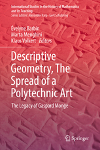- About MAA
- Membership
- MAA Publications
- Periodicals
- Blogs
- MAA Book Series
- MAA Press (an imprint of the AMS)
- MAA Notes
- MAA Reviews
- Mathematical Communication
- Information for Libraries
- Author Resources
- Advertise with MAA
- Meetings
- Competitions
- Programs
- Communities
- MAA Sections
- SIGMAA
- MAA Connect
- Students
- MAA Awards
- Awards Booklets
- Writing Awards
- Teaching Awards
- Service Awards
- Research Awards
- Lecture Awards
- Putnam Competition Individual and Team Winners
- D. E. Shaw Group AMC 8 Awards & Certificates
- Maryam Mirzakhani AMC 10 A Awards & Certificates
- Two Sigma AMC 10 B Awards & Certificates
- Jane Street AMC 12 A Awards & Certificates
- Akamai AMC 12 B Awards & Certificates
- High School Teachers
- News
You are here
Descriptive Geometry, The Spread of a Polytechnic Art

Publisher:
Springer
Publication Date:
2019
Number of Pages:
437
Format:
Hardcover
Series:
International Studies in the History of Mathematics and its Teaching
Price:
139.99
ISBN:
978-3-030-14807-2
Category:
Collection
[Reviewed by , on ]
Jemma Lorenat
02/16/2020
Descriptive Geometry, The Spread of a Polytechnic Art is a thorough book that presents the dissemination of descriptive geometry from its “birth” in Paris through the nineteenth and twentieth centuries. The breadth and depth of archival sources could only be accomplished through the international collaboration of scholars with access to handwritten lecture notes, school curricula, educational reforms, and examination questions. Such documents enable comparison between what government officials claimed should be taught and what students actually did in the classroom.
In the introduction, the editors refrain from strictly defining descriptive geometry. This initially appears as a peculiar omission, but in fact seems to reflect the malleability of the discipline’s contents across times and places.
In Germany, Nadine Berstein documents that “descriptive geometry was (and is) seen as the mathematical discipline that treats planar depictions of three-dimensional objects” (140). In Russia, Dmitri Gouzevitch, Irina Gouzevitch, and Nikolaj Eliseev show a focus instead on
the fundamental problems of descriptive geometry — its application to the construction of true and falling (from the sun and the point of light) shadows, black and light points, linear and aerial perspective which studied the rules for the representation of the gradual increase and decrease of light and shade depending on the degree of density or transparency of the air between represented object and pictorial plane (217).
Descriptive geometry was celebrated both as a means for strengthening visual intuition and as a service course to architecture, design, and engineering. These attributes also suggest the tenuous division between pure and applied mathematics, with descriptive geometry occupying a liminal position.
The text is organized geographically. Following the diffusion of descriptive geometry from France, the chapters are organized into three sections: First Spreading in Southern Europe, Installation of Descriptive Geometry in Europe, and Descriptive Geometry in America and Africa. Most chapters focus on a single country, and those with interests in certain national histories might fruitfully consult the text like an encyclopedia, reading the relevant chapters. Indeed, a prior knowledge of concurrent geopolitical events would likely help situate institutional and philosophical shifts in the teaching and learning of mathematics. Though the majority of the contributions focus on western Europe, the text also includes chapters on less well-documented sites of mathematical production during the nineteenth century, including Serbia, Egypt, and Brazil.
Each chapter follows a similar chronological structure, documenting the factors that shaped the national or regional approaches to descriptive geometry. Overall, the text emphasizes the complexity of educational systems with respect to status, pre-requisites, courses, costs, admission standards, time commitments, available texts, and student populations. With these potential differences in mind, it is remarkable that descriptive geometry spread so quickly and so far with any degree of uniformity. For those who read the volume in its entirety, certain cross-cultural themes emerge pertaining to translating and adapting technical terminology, the role of military defeats in funding mathematics education, and how technology — particularly photography — shaped applied geometry. The index might also serve as a useful aid in finding persons, texts, or practices that transcended national boundaries.
The book is named after Monge, yet Gert Schubring convincingly argues in the Epilogue that the École polytechnique did not effectively serve as a model for similar technical institutions in other countries. Nevertheless, many of the individuals who imported descriptive geometry from France were either French themselves or studied abroad at French institutions. The exception that proves the rule is England, where the only medium of communication was via textbooks and descriptive geometry remained a marginalized area of study.
As a final note, the cover illustration shows a close-up image of a cuneiform tablet, which is confusing given the many gorgeous colored images of planar figures inside the book. In particular, the many examples of precise student examinations are impressive.
Jemma Lorenat is an assistant professor of mathematics at Pitzer College. Her research explores visualization and communication in the history of geometry during the nineteenth century.
See the publisher's web page.
- Log in to post comments




